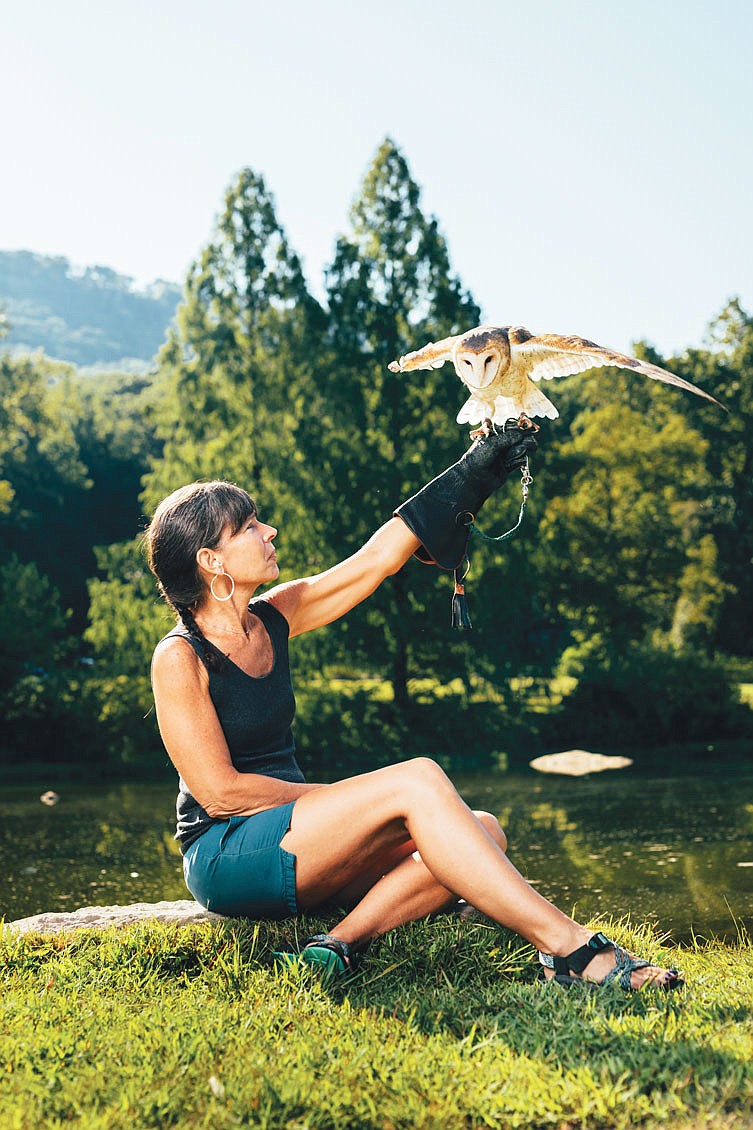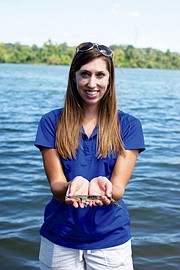Growing up, my family didn't go for beach vacations.
We camped.
For one glorious week during the summer I became my cousin's shadow as we caught frogs, chased violet butterflies and dodged poison ivy.
We hiked every day and I absorbed my dad's love for Tennessee forests and creatures. His endless knowledge of native trees and flora made every hike magical. He quizzed me on each species of tree, explained blights and beetles that threaten them. Every camping trip meant new discoveries.
I still love the sensations of being outdoors. And living in Chattanooga makes mountain access easy – downtown's hardly more than 15 minutes from trails and boulders.
"Outdoor beauty and unrivaled biodiversity are some of the key factors recruiting people to move to Chattanooga," says Bridgett Massengill, Thrive Regional Partnership President and CEO.
It's estimated that 59% of Chattanoogans participated in outdoor recreation last year. In 2012, the Ocoee River generated over $43 million in visitor spending, a study by the University of Tennessee at Chattanooga shows. Thrive's research estimates Tennessee outdoor recreation generates $1.4 billion annually, per data compiled by the Outdoor Industry Association.
"When you look at the economic value outdoor exploration and industry create, you're sharing the story and opening the eyes of our communities to the strong economic impact that outdoor recreation generates," Massengill says.
In addition to the economic value that outdoor recreation contributes to the region, Chattanooga nestles in one of the most biologically diverse areas of the world, specifically in terms of freshwater species.
"Tennessee is a biodiversity hotspot for freshwater fish. There is more freshwater diversity than anywhere else in the U.S.," says Meredith Harris, Reintroduction Biologist at the Tennessee Aquarium Conservation Institute.
Well-documented worldwide climate change and pollution from plastic, chemicals and agriculture threaten wild spaces and in our region 450 species of plants and animals are rare or imperiled.
Take the laurel dace for example, a small freshwater fish likely found in only two streams on Walden Ridge. If fish aren't your fancy, envision our red wolf. Roughly 257 red wolves live in captivity with 25 in the wild.
Luckily, local organizations work hard to conserve Chattanooga's wild spaces.
Tennessee Aquarium Conservation Institute
Lake sturgeon are a commercially and ecologically important fish native to our Tennessee River system. During the 1970s the fish went extinct across the Southeast due to commercial over-fishing and impoundment dams caused.
"Being in the industry of native freshwater fish conservation can be tough," Harris says. "Sometimes it feels like you're watching these fish slip through your fingers."
It's easy to wonder why conservation matters, especially for small fish species. The extinction of the laurel dace or the longhead darter won't change the landscape of your favorite hiking trail. In fact, small species extinction largely goes unnoticed by everyone except the scientists who study them.
Harris explains that conservation and extinction are like a Jenga tower, and the blocks are species of wildlife. Ecological Jenga blocks fall one-by-one as species go extinct until eventually our whole ecosystem comes tumbling down.
Over 30 years ago, fisheries biologists recognized the signs as an important Jenga block was pulled the lake sturgeon. To combat the trend, the Aquarium joined a collaborative team of federal and state agency biologists called the Lake Sturgeon Working Group to reintroduce lake sturgeon into local lakes and rivers. Slowly, with the help of many partnerships, the Tennessee Aquarium is seeing promising signs of success that populations are successfully being reintroduced.
"The lake sturgeon give us hope for other species. They were completely gone and now fishermen are catching them off dams. When we sample their populations, we're getting big numbers back," Harris says.
I accompanied the Tennessee Aquarium Conservation Institute on an outing to release baby lake sturgeon into a local lake. Harris and her team released over 700 fish on this outing, shining a light on the promising outlook of this 20-year conservation project.
Lake sturgeon are in good company when it comes to local repopulation efforts. With hard work and caring scientists, species populations rebound.
See Rock City Inc.
A nesting pair of peregrine falcons called Chattanooga home until 2005. Pesticide use thinned out their numbers to only that one pair. Birds migrate, making efforts to reintroduce species increasingly complex.
Peregrine falcons hatch in the U.S. and migrate to South America for a few years until they're ready to return with a mate. As predators, the falcon's main dietary staple consists of other birds. In South America the prey is much larger than what they find locally, contributing to a high mortality rate.
In 1992, peregrine falcons were critically endangered due to the widespread use of harmful pesticides banned in 1972. Cornell University started a breeding and release program that succeeded – peregrine falcons are no longer on the federal endangered species list.
While peregrine falcons are no longer federally endangered, locally their numbers have not bounced back. Rock City CEO Bill Chapin wanted to restore the falcon to our region.
See Rock City, Inc., in partnership with local non-releasable birds of prey organization Wings to Soar, has released 16 peregrine falcons since 2006. If a bird survives to adulthood, it typically returns to nest where it hatched.
Bald eagle populations in Chattanooga illustrate successful captive breeding and release programs. The last nesting pair was seen in 1962 and a reintroduction program launched in 1982. The first bird returned in 1984 with a mate. Now, there are 170 nesting pairs in Tennessee alone.
"We now have a pair of local peregrine falcons we are hoping to breed. We hope that within the next couple of years we will have some nesting pairs settling back here in Chattanooga," says John Stokes, Wings to Soar founder.
All peregrine falcons Rock City releases wear a leg band. The next time you're hitting your favorite local trail, keep your eyes peeled and if you see one, give Stokes a call.
Reflection Riding Arboretum and Nature Center
Reflection Riding is one of 42 rehabilitation facilities with programs to save the critically endangered red wolf. The red wolf is the only species of wolf native to the U.S. and at one point, there were only 14 left in existence.
Similar to conservation projects the Aquarium and Rock City offer, Reflection Riding works with partners nationally to reintroduce red wolves into the wild.
The red wolves program works extensively with the Species Survival Plan to pair captive wolves that are the most genetically compatible together to breed. Sometimes this entails flying or driving wolves across the country to pair the genetically diverse wolves.
In addition to the red wolves conservation program, Reflection houses numerous other species of wildlife at their facility. Visitors can experience the diverse beauty of native wildlife from barn owls to pine snakes.
Anthropogenic
An-thru-puh-gen-ik1 Caused or produced by humans
"All of our animals are here due to anthropogenic causes," says Tish Gailmard, Reflection Riding's Director of Wildlife.
The wildlife living at Reflection Riding have either become overly conditioned to human interactions or in the case of the barn owl on our cover, they've sustained life-altering injuries. Reflection Riding provides long-term care for each animal that calls Reflection home.
"Rehab facilities are good at placing animals that can't be returned to the wild. Even though these animals have permanent injuries, they become animal ambassadors. It's really important because people come and learn about these animals and what they can do to help prevent future injuries," Gailmard says.
When I toured Reflection Riding, Gailmard gave me tips on how to help prevent injuries to wildlife. Reflection's major teaching is the apple core theory.
"You're driving down the road and you toss an apple core out of the window. It's no big deal because it'll biodegrade, so it's not littering," Gailmard says. "As it breaks down, it attracts rodents. Birds perch in trees nearby and swoop down to catch them. On their way down or back up, they're hit by a car."
Gailmard says that 98% of birds housed at Reflection are there as a result of a car strike.
Another way to help local wildlife flourish is through creating a backyard habitat. All you need is water, shelter and food.
Thrive Regional Partnership
Partnerships and education are as important as scientific field work in conservation efforts. That's where Thrive Regional Partnership steps in. Their work focuses on supporting conservation efforts spearheaded by over 40 partnering organizations and educating the community on threats and solutions.
Thrive serves a 16-county jurisdiction that spreads across three states: Tennessee, Georgia and Alabama, collecting data and educating the region on everything from outdoor recreation revenue to local watershed quality.
"We collect data and use it to help educate stakeholders and elected officials across the region on what we're up against," Massengill says.
Consolidated conservation efforts reach farther, spreading positive impacts and doubling organizational resources. Two organizations may be focused on freshwater fish conservation and when they come together, they're able to stretch their efforts and resources twice as far.
"Before Thrive, organizations lacked a forum to communicate with each other. They were working alone in individual silos. Our biggest success is that we've been able to bring them together and hit our stride in interpreting the data from our region to help strengthen their work," Massengill says.
The best way to get involved in local conservation efforts is to get outside and enjoy the beauty around you. And bring some friends along.
"Stick your face in a stream and watch these colorful fish come out of the wood work. We live in the rainforest of aquatic systems right here in Chattanooga," Harris says. "We rely on these fish just like they rely on us."
Thrive has a bucket list map to help you get outside and enjoy the incredible place we live in. You can find it online at thriveregionalpartnership.org/natural-treasures-alliance or you can pick one up from your Chattanooga Chamber of Commerce. In the meantime, get out and explore the beautiful natural spaces of our region.

